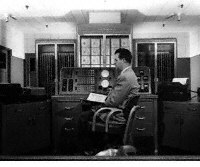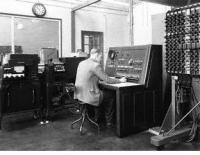|
|


 ERA 1101 drum memory
ERA 1101 drum memory
|
|
Computers
Engineering Research Associates of Minneapolis built the ERA 1101, the first
commercially produced computer; the company's first customer was the U.S.
Navy. It held 1 million bits on its magnetic drum, the earliest magnetic
storage devices. Drums registered information as magnetic pulses in tracks
around a metal cylinder. Read/write heads both recorded and recovered the
data. Drums eventually stored as many as 4,000 words and retrieved any one
of them in as little as five-thousandths of a second.

|
|
|
 SEAC
SEAC
|
|
Computers
The National Bureau of Standards constructed the SEAC (Standards Eastern
Automatic Computer) in Washington as a laboratory for testing components and
systems for setting computer standards. The SEAC was the first computer to
use all-diode logic, a technology more reliable than vacuum tubes, and the
first stored-program computer completed in the United States. Magnetic tape
in the external storage units (shown on the right of this photo) stored
programming information, coded subroutines, numerical data, and output.

|
|
|
 SWAC
SWAC
|
|
Computers
The National Bureau of Standards completed its SWAC (Standards Western
Automatic Computer) at the Institute for Numerical Analysis in Los Angeles.
Rather than testing components like its companion, the SEAC, the SWAC had an
objective of computing using already-developed technology.

|
|
|
 Pilot ACE
Pilot ACE
|
|
Computers
Alan Turing's philosophy directed design of Britain's Pilot ACE at the National
Physical Laboratory. "We are trying to build a machine to do all kinds
of different things simply by programming rather than by the addition of extra
apparatus," Turing said at a symposium on large-scale digital
calculating machinery in 1947 in Cambridge, Mass.
| Start of project: |
1948 |
| Completed: |
1950 |
| Add time: |
1.8 microseconds |
| Input/output: |
cards |
| Memory size: |
352 32-digit words |
| Memory type: |
delay lines |
| Technology: |
800 vacuum tubes |
| Floor space: |
12 square feet |
| Project leader: |
J. H. Wilkinson |

|

|
|

|
|
